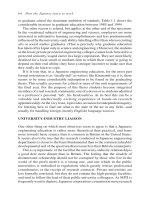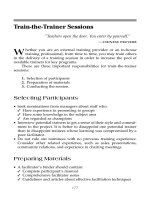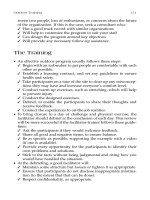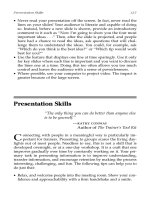The Trainer’s Tool Kit Second Edition phần 5 potx
Bạn đang xem bản rút gọn của tài liệu. Xem và tải ngay bản đầy đủ của tài liệu tại đây (353.86 KB, 22 trang )
82 Developing Training Programs
Pilot Programs
A
pilot program is a test run for a major training program that
allows trainers and developers to make adjustments based on
realistic feedback from participants, developers, and managers.
• As a general rule, pilot programs should be considered for any
program that will entail at least 1,000 trainee hours (for example,
200 participants for a five-day course.) The course may be either
classroom or technology based. This typically applies to:
✓ Training large groups that must receive a consistent message
and support for key skills
✓ Training that supports the introduction or upgrade of expensive
equipment
✓ Training that will/must be delivered at different levels and in
different locations
✓ Training that will be conducted over a period longer than a year
• The team for evaluating and adjusting a pilot should consist of
representatives from:
✓ The client group ( the client is the owner of the business process;
for example, customer service: sales dept., coaching skills:
human resources)
✓ Design and development team (these may be internal or external
parties)
✓ Skilled facilitators and trainers who will not be delivering the
course (these are more likely to see the ‘‘bigger picture’’ than
designated facilitators)
✓ Representative trainees from the target training population
• Designate a member of the team to:
✓ Set parameters—what costs and time commitments are realistic
for making changes now; what adjustments might occur after
multiple presentations.
✓ Determine what the priority decisions are—that is, content,
course length, and so forth.
✓ Beyond overall impressions, assign specific tasks to each evalua-
tion team member, for example, observing participant energy
PAGE 82
10916$ $CH4 10-21-04 08:00:36 PS
83Pilot Programs
levels; observing whether exercises can be conducted in the sug-
gest time frames.
✓ Set a deadline for gathering observations and making changes.
✓ Design a simple tool for written observations (rather than col-
lecting only verbal impressions). The tool should emphasize the
intended outcome of the course (one or two key learning objec-
tives) as the basis for observations.
• The elements of the course that will be evaluated include:
✓ Pre- and post-course assignments
✓ Logical sequencing of messages and materials
✓ Appropriate course length
✓ Meaningful skill outcomes for practice exercises
✓ Balance of lecturing and participation
✓ Technical reliability of any training technology
✓ Clarity of learning outcomes
✓ Usefulness of the course evaluation questionnaire
✓ Participant and customer satisfaction
• The following questions should be reviewed after a pilot presenta-
tion:
✓ Is the room size and set-up important to the learning?
✓ Is the subject matter likely to change over time, and if so, how
will the course be adapted?
✓ If training technology is involved, is there adequate technical
support at all training locations?
✓ Does the course rely on trainers who are specifically trained for
the launch? Can other trainers—at other locations—be brought
up to speed?
• Here are some cautions about conducting a pilot program:
✓ Do not have more than three observers in the room; large teams
of observers can dominate and distract the actual participants.
✓ Beware of the tendency to observe only what is wrong, rather
than what is working.
✓ Do not choose a select group of participants or high performers
for a pilot; this will not give you a realistic picture of the typical
trainee population.
✓ Do not rely solely on post-course evaluations; follow up with
trainees two or three weeks after the course is completed.
PAGE 83
10916$ $CH4 10-21-04 08:00:36 PS
This page intentionally left blank
V
Delivery Options
M
odern technology allows us to train people in the four cor-
ners of the globe simultaneously. Part V examines the in-
creasing number of options available and reviews the
merits of each.
PAGE 85
10916$ PRT5 10-21-04 07:58:25 PS
This page intentionally left blank
Technology: Choosing High-Tech or
Low-Tech
D
ecisions about the appropriate medium for a training course
begin with the client who is sponsoring the training initiative.
Choosing the best medium begins with an understanding of the key
objectives for the program.
• The following questions are helpful when meeting with in-house
clients to set objectives:
✓ How was the training need identified?
✓ How will a program’s success be measured?
✓ Is the training need a business need, a turnover requirement, or
a personal-development need?
✓ Should the current in-house program be updated to reflect new
corporate policies or procedures?
✓ Does every employee in the target group need the training?
✓ Will the program be repeated year after year for new audiences?
The answers to these questions will give an overall scope to the
program, in terms of size, success measures, target population, and
continuing availability.
• The emergence of sophisticated multimedia training tools has been
heralded as a cost-effective way to manage learning for large popu-
lations. This has also sparked debate about the effectiveness of
classroom training versus individual learning, together with the
costs and benefits of each.
• There are four training medium choices:
1. Classroom training
2. Multimedia training for group presentations
3. Self-directed tools (e-learning)
4. Blended learning that combines all or some of the above
• Factors that influence the appropriate choice are:
✓ Current technology proficiency and confidence level of partici-
pants
✓ Importance of practice and immediate feedback to the intended
learning outcome
PAGE 87
87
10916$ $CH5 10-21-04 08:00:38 PS
88 Delivery Options
✓ Development deadline and budget
✓ Numbers of employees in the target population
✓ Geographical distribution of target population
✓ Measurement tools to assess learning outcomes
• These elements will help you to create a situation analysis for as-
sessing the advantages and disadvantages for a high-tech or low-tech
environment.
Multimedia (High-Tech)
Advantages Disadvantages
• reduced demand on trainers • assumes computer literacy
• provides remote site delivery • no immediate response to dif-
ficult questions
• employees learn at their own • expensive to develop and in-
paces stall
• consistent delivery • no chance to practice new
skills for immediate feedback
• modules can be used for • no interaction with other
follow-up and refresher train- learners
ings
• reduces travel and facilities • cannot be easily updated
costs
Classroom Training (Low-Tech)
Advantages Disadvantages
• more participative and ener- • difficult to schedule employees
gizing
• provides hands-on practice • expensive scheduling and ad-
ministrative time
• trainer can monitor impact • requires guaranteed number of
participants
PAGE 88
10916$ $CH5 10-21-04 08:00:38 PS
89E-Learning
• can be adapted to specific skill • travel costs for both partici-
levels pants and facilitators
• opportunity to learn from
others
• The following important considerations go beyond cost and avail-
ability:
✓ Many teleworkers prefer training where they can interact with
others.
✓ Trainees should only be learning one key skill in a course, so
ensure that they are not learning to cope with the technology as
well.
✓ The mix of trainees: Are they all operating at the same skill level
before the training? If not, independent learning may be advis-
able.
• More and more programs are combining elements of classroom
learning with online availability for complex lessons and self-paced
follow-up, which combines the advantages of both high-tech and
low-tech solutions.
E-Learning
E
lectronic or e-learning can be defined as any type of learning that
is enhanced, either partially or fully, by some electronic form of
communication. Electronically delivered learning will become in-
creasingly important as tools become easier and less expensive, and
technologies become available to people around the world. A great
deal of confusion exists around e-learning, so here is an overview of
the topic looking at it from both the training manager’s and the learn-
er’s perspective.
• There are many forms of e-learning. The most common are:
✓ In-house computer training
✓ Web-based training
PAGE 89
10916$ $CH5 10-21-04 08:00:39 PS
90 Delivery Options
• In-house learning refers to skills development on a single subject,
typically contained on a CD-ROM. The CD will allow the learner
to conduct his or her own training in a self-paced process that
could be done either individually or in a classroom. Working with
an instructor enables the less-secure learner to ask for help in the
event of technical problems.
• The two types of available Web-based training are:
✓ Asynchronous training
✓ Synchronous training
Asynchronous training is learning that allows trainees to log in
to a Web site and choose from a menu of topics so that they can learn
on their own. Synchronous training, on the other hand, is training
that is offered on the Web that is done in a virtual classroom and is
led by a facilitator. The students are located remotely, using their
computers, to follow a lesson and interact as the need may arise.
Web-based training will become increasingly popular because it
has several advantages, including:
• Reduction of Costs. The dollars associated with off-premise train-
ing can be considerable. The costs of travel, accommodation, and
time away from work often exceed the cost of the actual training.
This is a significant consideration for people outside of metropoli-
tan areas.
• Ability to Include a Mobile Workforce. Increasing numbers of peo-
ple are operating in a virtual environment, with many working
from home offices and hotel rooms around the globe. Having them
all receive the same training, with the same message, can be impor-
tant.
• Flexibility. Asynchronous training allows learners to take a mod-
ule anytime they have the time and inclination. Synchronous train-
ing also allows for some flexibility as modules are typically
scheduled in advance, taking typically ninety minutes from a per-
son’s work week instead of an entire day or days.
• Web-based synchronous training has several advantages for the
participants, because they can:
✓ Do projects together, such as construct a spreadsheet or map a
process—both of which have real-world value
✓ Find examples of a concept on the Web at the same time that
they are monitoring the program
PAGE 90
10916$ $CH5 10-21-04 08:00:39 PS
91E-Learning
✓ Have access to virtually every library and book that exists
✓ Meet new peer groups around the world, with whom they can
share wisdom
✓ Develop networks that are likely to continue long after the for-
mal sessions have been completed
• Web-based training is particularly suited to people who share the
following characteristics:
✓ Are mobile
✓ Time pressured
✓ Self-directed and determined to complete their program
✓ Comfortable with technology
✓ Have access to a reliable ISP provider (taken for granted in most
Western countries)
• Evaluating a Web-based program can be challenging. Delivery plat-
forms should be compared for their ease of use, reliability, and
support.
• A good asynchronous program (and module) should be designed
so that:
✓ The technology can be demonstrated for first-time users.
✓ The vendor has 24/7 technical assistance available on an 800
number.
✓ Each module:
• Has clearly defined objectives and an agenda
• Is short and to the point
• Allows the user to see and hear the text as well as videos of
behaviors that may be illustrated in soft-skill training
• Should not exceed fifteen minutes in length before it stops to
obtain feedback from the participant in the form of a quiz
✓ Programs are available in multiple languages to suit the learn-
er’s needs.
✓ The moderator can:
• Move forward or back using PowerPoint slides
• Track who has logged in
• Mute some or all of the lines
• ‘‘Lock’’ or ‘‘unlock’’ the workshop at any time
• Have instant access to technical support
• Track participative behavior such as the time logged in and
out and time when the participant might have wandered away
from the computer
✓ Modules should be staggered so that people can fit them into a
PAGE 91
10916$ $CH5 10-21-04 08:00:39 PS
92 Delivery Options
busy work schedule. Experience suggests that each module
should not exceed ninety minutes in length nor have more than
twenty people in the virtual classroom. Less is better.
✓ It can be recorded and accessed via the Web by students who
might have missed the session.
• Web-based synchronous training programs are new to the vast ma-
jority of learners and training managers. For the trainer, there are
many advantages, such as:
✓ Being able to network with people around the world.
✓ Access to trainees who would never have this opportunity.
✓ The ability to work at home in your pajamas!
✓ No requirement for you to be in a classroom; you can teach from
wherever you happen to be: in your office, at home, or on the
road.
• Evaluation of Web-based synchronous training is difficult; how-
ever, the most effective of these programs provide:
✓ Full-duplex sound technology that allows voice and data to flow
both ways simultaneously. Previous generations would only
allow for transfers of voice and data to be one at a time, thereby
blocking one source that may be transmitting inadvertently.
✓ Secure access to its own URL with password protection.
✓ The use of the PC to deliver visual signals but separates the
audio, which can be delivered as Voice over Internet Protocol
(VoIP) or via the telephone.
✓ Adequate staffing to ensure success, including:
• A facilitator who has the ability to communicate clearly and
adjust his/her voice to advantage
• A technical ‘‘copilot’’ who is available to ensure that the ser-
vice is being provided with no hitches
✓ Access via an international toll-free number.
• Features of excellent Web-based software include:
✓ An ability to move back and forward in the materials
✓ Instant access to help via two media: a help button on the screen
and a help desk
✓ Information about the instructor
✓ An ability to interact with the instructor and other participants
✓ An ability to pause the materials (slides)
✓ An ability to see all the materials (slides)
✓ Reference links, such as URLs
✓ An ability to bookmark materials, if called away
PAGE 92
10916$ $CH5 10-21-04 08:00:40 PS
93E-Learning
✓ An ability to see the notes on each slide
✓ A quiz to check for understanding
• There are drawbacks to Web-based programs, which include:
✓ Lack of consistent adequate technology internationally. While
the technology may be global, the access is dependent on local
availability of reliable telephone services—something people
take for granted in Western countries.
✓ A perceived lack of social contact. Although people can interact
with each other, soft-skills training is undoubtedly better face-
to-face.
✓ Difficulty in doing some types of experiential exercises, such as
group work.
✓ Catering primarily to auditory and visual learners and less to
kinesthetic learners.
✓ Unforeseen technical hitches and other irritants may include:
• Participants putting their telephones on hold and having the
rest of the group subjected to music that kicks in
• Participants’ not having immediate access because the com-
puter they are using has temporarily lost access to the Internet
because the local provider is ‘‘down’’
• A local computer the participant is using has an older version
of the Web browser and is unable to log in
• A telephone echo that makes some feel like they talking to
people on another planet
✓ Difficulties with group dynamics that are multiplied when the
facilitator is not able to see what is happening and has to rely on
participants speaking up; this includes the following:
• People not listening to each other and then asking questions
that have been dealt with
• One or two people dominating the conversations
• Participants not using features such as ‘‘raising hands’’ and
sending text questions, thereby allowing the moderator to ex-
ercise control over the group
• One or two participants speaking continuously when not
asked or required, thereby interrupting the flow of informa-
tion for the other participants
• Participants refusing to use the software features such as
‘‘raising hands,’’ allowing the moderator to invite comments
at appropriate times
PAGE 93
10916$ $CH5 10-21-04 08:00:40 PS
94 Delivery Options
• Deciding on whether to create an organization’s own Web-based
training program will be influenced by factors such as:
✓ The size of the organization
✓ Its geographical spread
✓ Available resources
✓ The type of people it wishes to train (technical abilities)
✓ Sophistication of the designers and access to appropriate tech-
nology
✓ Availability of a suitable vendor with which it can partner
Videoconferencing
‘‘Words mean more than what is set down on paper.
It takes the human voice to infuse them with shades
of deeper meaning.’’
—maya angelou
Poet, Educator, Author, and Activist
V
ideoconferencing is the process whereby people all around the
world can gather at prearranged facilities and participate in
training. This format is most frequently used to bring the biggest
audience at reasonable cost to listen to popular speakers who typi-
cally command fees running into tens of thousands of dollars. This
format is also being used by business schools that are increasingly
encroaching into the territories of other schools with the objective of
adding to their student populations and revenues.
• Videoconferencing works best when:
✓ The system is backed by reliable technology that guarantees 100
percent uptime.
✓ Images are available on a big screen allowing everyone in the
audience to see the speaker clearly.
✓ The speaker can cut to a split screen from time to time so that
the audience can see complementary slides.
PAGE 94
10916$ $CH5 10-21-04 08:00:40 PS
95Videoconferencing
✓ Time is provided for local discussion.
✓ The information is interesting but not too complex. The pre-
senter is generally unable to know whether a point is under-
stood or not.
✓ There are sufficient short breaks to allow people to clear their
heads, stretch, and prepare for more information download.
✓ Participants are not packed into halls with theater-style seating,
but are given the opportunity to have a workbench to put mate-
rials on, including laptops.
• The success of the training greatly depends on having an excellent
presenter. Ideally, he or she should:
✓ Be respected in his or her field
✓ Have an excellent presence
✓ Be able to ad-lib without the use of notes
✓ Have a strong, commanding voice
✓ Be animated and engaging
• Videoconferencing may not be the most effective tool to promote
learning retention as the process rarely allows for practice of the
skills. Therefore, it is a good medium for theory only but needs to
be supplemented by local group work that encourages discussion
and practice, if appropriate. A good program will use only part of
the time for presentation, with the balance of the time being given
for small group discussion.
• If the audience is not too widely dispersed and the number of stu-
dents not too large, it may be possible to provide some interaction
between the audience and the presenter. This can be done by pro-
viding microphones interspersed around the room for questions
from the audience or to enable small-group spokespersons to pres-
ent key ideas.
PAGE 95
10916$ $CH5 10-21-04 08:00:41 PS
96 Delivery Options
Self-Directed Learning
‘‘We can only have citizens who can live
constructively in the kaleidoscopically changing
world ifwearewilling for them to become self-
starting, self-initiating learners.’’
—carl rogers
Psychologist and Author of Freedom to Learn
M
any individuals are capable and willing to take responsibility
for their own learning. These people can create and monitor
their own progress toward learning goals using fewer resources.
• Self-directed learners are more willing to:
✓ Take the initiative to learn
✓ Diagnose their own needs
✓ Set learning goals
✓ Find the resources
✓ Pick the method of learning that most appeals to them
✓ Implement the learning
✓ Evaluate the outcome
• Knowledge and skills can be acquired independently in a number
of ways:
✓ Books
✓ Self-study programs on tape (audio disk)
✓ Videos
✓ Self-paced textbooks
✓ Computer-based training
✓ Interactive video
✓ Internet-accessed materials
✓ Mentors
✓ Coworkers
✓ Magazine and journal articles
✓ Observation
✓ On-site courses
✓ Workshops and seminars
• The advantages of self-directed learning are:
PAGE 96
10916$ $CH5 10-21-04 08:00:41 PS
97Self-Directed Learning
✓ The learner has control over pace.
✓ Ownership is high.
✓ Costs are low.
✓ The learner can customize the content.
✓ Training can take place during slow periods of the day.
• Some disadvantages of self-directed learning are:
✓ Most programs contain generic materials, parts of which may be
unhelpful for the learner.
✓ Written materials usually can be used only once and cannot be
duplicated without breaking copyright laws.
✓ It is difficult to learn managerial skills by any method other than
experiential. An understanding of materials may not lead to ef-
fective application.
✓ The rate of dropout of self-directed programs is higher than that
facilitated by a trained instructor.
• Strategies to evaluate packaged programs include:
✓ Comparing the documented objective against your own.
✓ Checking with others who have used the materials. (Be cautious
of this information. Consultants are unlikely to supply the names
of unhappy customers.)
✓ Checking with your own network of trainers.
✓ An estimation of the shelf life of the materials. The longer you
can use them without a major update, the more cost-effective
they become. Technical subjects date a lot quicker than manage-
rial topics.
✓ Calculating and comparing the cost per trainee for each pro-
gram.
• The following guidelines are important when using self-directed
learning programs:
✓ Ensure that materials, such as workbooks and computers, are
always available.
✓ Make coaches available for those who need encouragement,
guidance, and redirection if they hit a roadblock.
✓ Provide opportunities for people to check their knowledge
through self-scoring systems or tests that can be checked by an
expert.
✓ Check that the majority of people reach their objective.
✓ If course-learning objectives are not being met by most people,
investigate the cause.
PAGE 97
10916$ $CH5 10-21-04 08:00:41 PS
98 Delivery Options
✓ If dropout rates begin to rise, find out the reason and fix the
problem.
✓ Regularly update materials to ensure that they are easy to follow
and error-free.
✓ Pilot-test new programs to remove bugs.
• Self-directed learning is enhanced if the learner commits to a writ-
ten plan. It will ‘‘force’’ participants to:
✓ Develop clear learning objectives
✓ Identify actions that will lead to the achievement of those objec-
tives
✓ Set completion dates
✓ Decide how they will know in measurable terms when they are
finished
An example of a format for this plan can be found in Exhibit 6.
Exhibit 6. Self-directed learning plan.
My The Steps I
Learning Intend Target Evaluation
Objectives to Take Date Method
PAGE 98
10916$ $CH5 10-21-04 08:00:42 PS
99Computer-Based Training
Computer-Based Training
‘‘I do not fear computers. I fear the lack of them.’’
—isaac asimov
Futurist and Author
C
omputers are becoming a dominant tool for training, as well as
the predominant tool for communicating. In fact, this medium
is growing faster than other forms of training delivery. Here is an
overview on the use of CD-ROMs and interactive videodisks.
• Computer-based training (CBT) refers to learning that is conducted
through the medium of a computer. The applications of this mode
of instruction are growing daily in terms of quantity and quality.
While earlier versions of CBT focused on the individual learning
on his or her own, the advent of the Web has made distance educa-
tion, with a live moderator, accessible to people around the world.
The primary methods of computer-based training include:
✓ Interactive videodisk instruction
✓ CD-ROM
✓ Web-based distance online learning
✓ Web-based training on demand
• CBT is a fascinating and exciting medium for training, but it is by
no means immune to problems of poor design.
• As more people become exposed to animation, virtual reality, and
the sophistication of video games, it has become increasingly diffi-
cult to design videodisk and CD-ROMs that will challenge, stimu-
late, and hold the attention of learners for any reasonable time, let
alone teach them.
• Experience shows that CBT, like other forms of training, needs to
be:
✓ Focused on a single topic
✓ Customized for a particular organization or industry
✓ Integrated into other forms of learning that will reinforce and
lend variety to the learning experience
• CBT can never take the place of human interaction. It is unrealistic
to consider CBT as the ultimate and only form of training.
PAGE 99
10916$ $CH5 10-21-04 08:00:42 PS
100 Delivery Options
• CBT is most effective when it is designed to work like the human
brain, an undisciplined organ that likes to flow from one idea to
another. Therefore, CBT that provides only for multiple-choice re-
sponses or enables a person to move from one screen to the next in
a predesigned sequence will be far less effective than a process that:
✓ Allows the learner to move to topics of his or her choice in a
random fashion
✓ Provides feedback on the learner’s effectiveness, particularly
when the person has made a mistake
✓ Enables the learner to use a variety of tools to navigate through
the learning process
• CBT that relies on sound, animation, and color to maintain learn-
ers’ attention is much less effective than a technology that allows
for an interactive response through video clips or responsive ani-
mation.
PAGE 100
10916$ $CH5 10-21-04 08:00:42 PS
VI
Conducting Training
PAGE 101
10916$ PRT6 10-21-04 07:58:27 PS
This page intentionally left blank
Preparation for Training
‘‘Spectacular achievement is always preceded by
spectacular preparation.’’
—robert h. schuller
Televangelist
P
roper preparation for training will allow you to present informa-
tion in a relaxed, effective, and professional manner. The follow-
ing list will help you to avoid some common pitfalls.
• Book meeting rooms early, advise attendees of the location, and
provide maps to it if necessary.
• Confirm the number of attendees.
• Assemble your materials and supporting documentation.
• Confirm your meeting room reservation and ensure that refresh-
ments have been ordered.
• If the presentation is complex, have a package of information pre-
pared for each participant. Distribute these packages in advance
for everyone to review prior to the session.
• Do a dry run to test the materials and your self-confidence. Imagine
the audience in front of you. Gauge their reaction. Consider video-
taping your practice session so that you can refine it as may be
appropriate.
• Review your objectives to make sure they are in line with what you
intend to deliver. Better still, make sure that what you intend to
deliver is directly related to the objectives.
• Assemble a backup emergency kit of markers, masking tape, name
cards, pencils, pens, and spare bulbs for equipment.
• Meet with some attendees beforehand to gauge their enthusiasm
for the upcoming presentation or their concerns. If you detect any
resistance, give them an opportunity to vent by:
✓ Listening
✓ Showing empathy
✓ Offering to address their concern if at all possible
• Learn as much as you can about the training audience: their skill
levels, demographics, and prior training experiences.
PAGE 103
103
10916$ $CH6 10-21-04 08:00:44 PS









